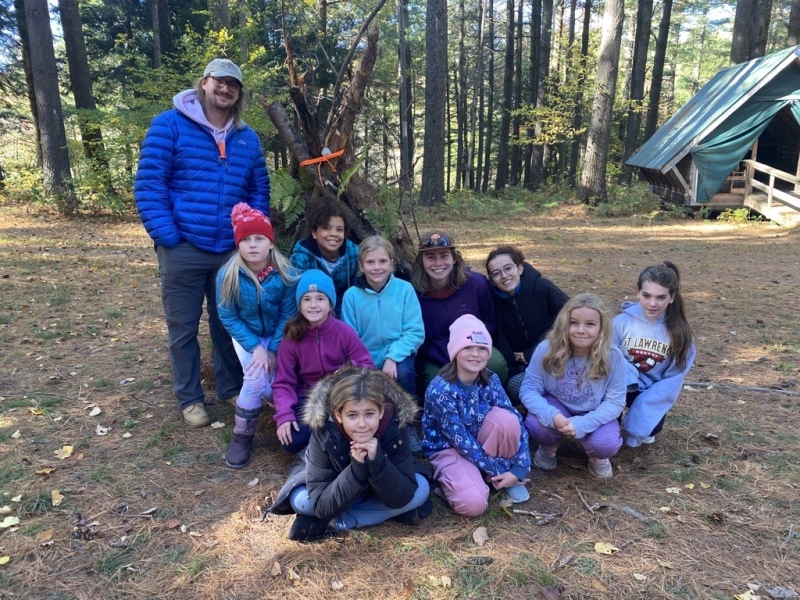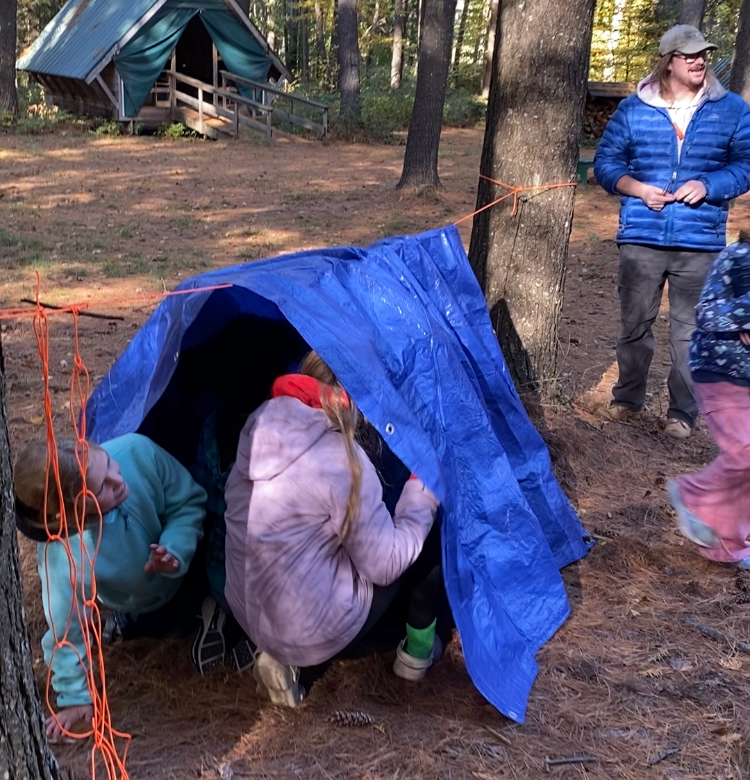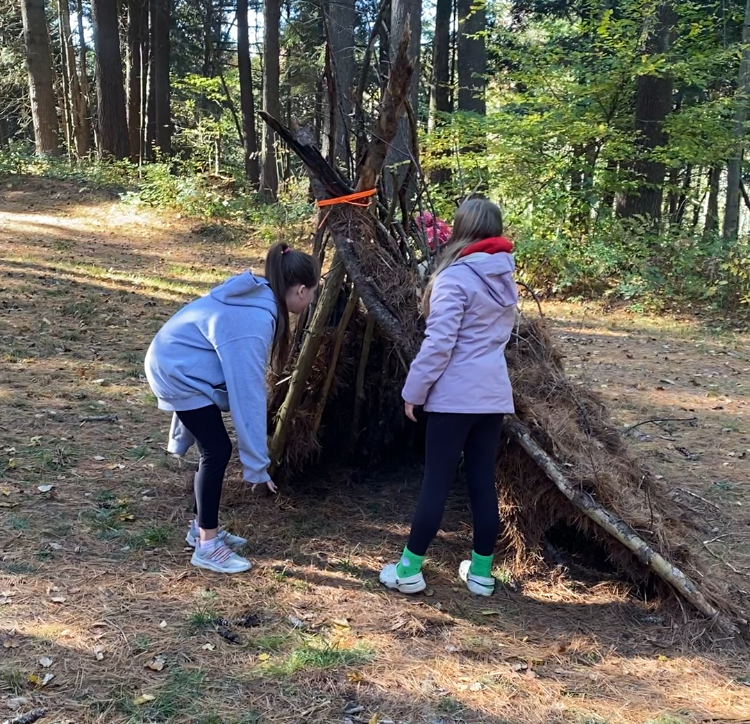
Event Recap - Girl Scout Survival Day!
As part of a unique program, I recently had the opportunity to attend a Girl Scout event that left me both inspired and enlightened. This experience not only allowed me to connect with our community's youth but also taught me valuable skills and deepened my appreciation for nature. What struck me most was the girls' enthusiasm and thirst for knowledge. Their curiosity about our surroundings was contagious, reminding me of the importance of maintaining a lifelong love for learning
Knots
Although it was a rather cold morning, we kicked right into work. Nature Up North Environmental Education Intern Bryn started us with a lesson on knots, trying to squeeze our muscles and give us a quick challenge to wake up and kick-start the day. I was a very slow learner compared to the girls, who at some points started teaching me. Each of the knots taught during the first lesson are knots that are useful for shelter building. They can also be used more generally by creative Girl Scouts when building a successful campsite!
Here are some basic instructions for knot tying. Having learned that I may not be the best at tying knots, the videos we used to learn these knots ourselves are linked in each knot name to help you understand and practice these knots too. But, before we dive into the knots, let's clarify two important terms used in knot tying. Understanding these terms will make following knot-tying instructions much easier:
• Standing end: This is the longer part of the rope that is not actively being used in tying the knot. It's typically the end attached to something or the main body of the rope.
• Working end: This is the free end of the rope that you're actually using to tie the knot. It's the end you'll be manipulating to create the knot.
Square Knot: Used for joining two ropes of equal thickness. This knot is useful for creating a loop by tying the ends of the rope together, or for combining two ropes into one.
-
Cross the right end over the left.
-
Bring the right end under and up through the loop.
-
Repeat with the left end going over, under, and up.
Bowline Knot: Creates a fixed loop at the end of a rope. This knot is often used for tying one end of a rope around something, like a tree. It's unique in that it stays tight under tension, but can still be undone easily if the rope is slacked.
1. Make a small loop in the standing end of the rope.
2. Pass the working end up through the loop, around behind the standing end, and back down through the small loop.
Slip Knot: A slip knot is a quick release knot, meaning it is designed to untie easily and at a moment's notice. This is used often in shelter building to make camp easier to take down.
1. Form a loop in your rope.
2. Grabbing from either side of your loop, pull a section of rope (not the end) through your loop. Be sure that you pull your section of rope through the opposite side it leaves the loop from. If your section of rope leaves the loop from the top, pull it through from the bottom and vice versa.
3. Pull your loop tight around the section, forming another "loop" in your knot. Notice how pulling on one end of your rope pulls the loop out, and the other doesn't, and how placing something like a stick through the loop like a toggle keeps it from untying.
Trucker's Hitch: This is a series of knots used to pull a rope tight, and then keep it tight. Often, this is used to form a ridgeline for shelters or clothes lines.
1. Pick two trees to use as the ends of your ridgeline. Tie a bowline knot around one of them.
2. Pull your rope around the other tree and back towards the first. In your standing end (between the trees), form a slip knot.
3. Put the working end of your rope through the loop in the slip knot, and pull it back towards the second tree. This pulls tension into your line.
4. Using another slip knot with a toggle, or a bowline knot, tie the working end of your rope off to hold tension in the ridgeline. This part can be tricky with one person, so have someone keep pulling the rope while you tie the knot, or practice doing it by yourself.
Taut-Line Hitch: Like the trucker's hitch, this knot is designed to pull and hold tension in a rope to form a ridgeline. The difference, is this knot is easily adjustable up and down the rope for a more variable tension.
1. Pick two trees to use as the ends of your ridgeline. Tie a bowline knot around one of them.
2. Pull your rope around the other tree and back towards the first. Using your working end, wrap it around your standing end twice making sure the second wrap is closer to the tree than the first.
3. Wrap a third time on the side of your wraps furthest from the tree, and in the opposite direction as your first two wraps, pulling back through the between the standing and working ends. That's it!
Shelter
After learning the basics, we started putting our knots into practice with shelter building, but before any shelters could be built a proper campsite had to be picked. This is where our first bit of nature knowledge came into play. The woods of the North Country have a diverse set of trees that provide a diverse range of conditions. At Camp Trefoil, the forest is dominated by white pines. As pine trees grow taller, they let their lower branches die off in a bid to conserve resources. This results in something called a “widow-maker”. Widow-makers got their name for their uncanny ability to fall off of the tree onto unsuspecting campers who put their shelters too close to a tree, so our girls picked a spot with a wide gap in the canopy above their heads to build their shelter. Conveniently, the widow-maker branches that had already fallen are great materials for the shelter they're about to build!
We built two kinds of shelter. One was a simple tarp shelter using common camping materials: a tarp, rope, and tent stakes (or sticks). The second shelter was much more DIY, using only materials we could find in the forest and one piece of rope. Here's a step-by-step guide to building both these shelter:
Tarp Shelter:
1. Find two sturdy trees: Look for trees about 10-15 feet apart with a clear space between them.
2. Tie a ridgeline: Use a strong rope to tie a line between the two trees at about chest height.
3. Secure your cover: Drape your tarp or cover over the ridgeline, ensuring it's centered.
4. Stake down the sides: Use stakes or rocks to secure the edges of your cover to the ground.
5. Create a moisture barrier: Place leaves or pine needles on the ground inside your shelter for insulation. It is best to have a second tarp to place on top of these.

All DIY Shelter:
1. Find three long, sturdy sticks: Look for branches about 6-8 feet long.
2. Arrange in a tripod shape: Stand the sticks up and lean them together at the top.
3. Tie the sticks together: Use a strong cord to bind the tops of the sticks securely A square knot is perfect here for tying the ends of the rope together once it has been wrapped around the sticks forming the tripod.
4. Add ribs on two sides: Place additional branches around the tripod frame filling in as many gaps as possible.
5. Cover the structure: Layer pine needles in big clumps over your ribs.
6. Create a thick ground cover: Use more pine needles and leaves inside for insulation.

After we finished, we dismantled everything and cleaned the space. This practice aligns with the "Leave No Trace" principles, which are fundamental guidelines for minimizing our impact on the environment. These principles include: plan ahead and prepare, travel and camp on durable surfaces, dispose of waste properly, leave what you find, minimize campfire impacts, respect wildlife, and be considerate of other visitors. By following these principles, we ensure that future generations can enjoy the same natural spaces we do today. It's crucial not to damage the environment due to mistakes or lack of knowledge. It is important to recognize that pine needles and sticks provide important ground cover and shelter for lots of creatures, and act as a mulch covering the soil ecosystem below.
During our shelter-building exercise, Nature Up North Project Manager Dan shared a story about the eastern white pine (Pinus strobus). These trees reach towering heights, with some historical records mentioning white pines growing up to 230 feet tall. They played a crucial role in building New England, as their wide, knot-free lumber was highly prized for flooring, paneling, and structural elements. Beyond its practical uses, the white pine holds deep cultural meaning, especially for the Haudenosaunee or Iroquois Confederacy. Composed of five original nations, the Confederacy found inspiration in the white pine's bundles of five needles, symbolizing unity and strength. This led to the white pine being revered as the "tree of peace." Later, a 6th nation was added, creating the Iroquois Confederacy that existed when Europeans came to the Americas.
Fire
The most exciting part was learning to build a safe fire. We created a nest using pine needles, twigs, and small pieces of chopped wood, and learned about the delicate balance needed to start and maintain a fire. The girls were captivated by the process, understanding the importance of each element in the fire triangle. Heat, fuel, and oxygen make up the three sides of this triangle, and all are needed for a fire to start. Too much of one, or too little of another can destabilize a fire stop it from lighting, or put it out. Each girl also got a turn to try and use flint and steel to start their fire! Here are the steps we followed:
1. Gather materials: Tinder (dry leaves, birch bark, pine needles), kindling (small twigs), and larger fuel (large sticks).
2. Create a tinder bundle: Loosely bunch up your tinder materials.
3. Build a log cabin structure: Stack your wood pieces like a log cabin and arrange kindling around the tinder bundle inside the structure, leaving an opening for air.
4. Light the tinder: Use matches or a fire starter to ignite the tinder bundle.
5. Add fuel: As the fire grows, gradually add larger pieces of wood.
6. Extinguish the fire properly: When it's time to put out the fire, follow the "smother, stir, smother, stir" method:
-
Smother the fire with water or dirt
-
Stir the embers to expose hot spots
-
Smother again with more water or dirt
-
Stir once more and check for any remaining heat
Repeat this process until the fire site is cool to the touch. This ensures that the fire is completely out and prevents any chance of reignition.
To cap off our wonderful day of learning and adventure, we indulged in everyone's favorite campfire treat: s'mores! The girls expertly roasted marshmallows over our safely managed fire, sandwiching them between graham crackers and chocolate. It was the perfect sweet ending to a day filled with new skills, friendships, and a deeper connection to nature.
This event reinforced the importance of community engagement. By participating in these activities with the Girl Scouts, we're not just teaching skills; we're building relationships, fostering a sense of belonging, and nurturing future leaders. As I reflect on this experience, I'm reminded of the vital role programs like this play in our community. They provide a platform for intergenerational learning, connect us with nature, and instill valuable life skills. The eagerness and capability of these young scouts give me hope for the future of our community and our relationship with the natural world.

